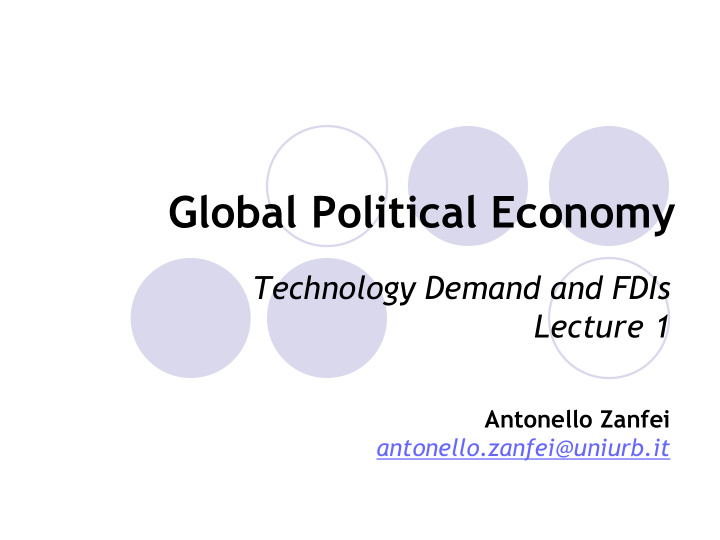



Global Political Economy Technology Demand and FDIs Lecture 1 Antonello Zanfei antonello.zanfei@uniurb.it
Our point of departure: Increasing FDI/Export ratio
Connecting to previous lectures The choice between Export and FDIis under monopoly is affected by sector and country specific characteristics, inter alia by trade costs However standard monopoly models with trade costs do not explain the paradox of increasing FDI/Export ratio Considering different types of FDIs helps frame the paradox and explain why FDIs may increase in the presence of diminishing trade costs Introducing Oligopoly assumptions and taking into account technological advantages and firm heterogeneity also helps explain the paradox
Today’s focus Interactions between demand and technology factors in shaping exports and FDIs Technology accumulation approaches to internationalisation Ex ante and ex post technological advantages as drivers of FDIs Measuring asset exploiting and asset seeking FDIs
Interactions between technology and demand factors Vernon’s Product Life Cycle (1966) Historical setting: US technological leadershiop and multinational growth after WWII Trade and FDI are innovation driven Innovation is demand led: US consumers and user firms are more advanced and induce early introduction of technology in the US market
Vernon (cont’ed) – Phase 1: new product is produced for local market – Phase 2: new product is exported when local market is exhausted and foreign (EU) markets emerge for it – Phase 3: product gets standardised and its price elasticity increases FDIs to react to competitive threats from firms in local markets via cost reduction and proximity to consumers – Phase 4: product reaches maturity, actual competition increases in the EU market EU market is abandoned and less developed markets are exploited though FDIs new product are introduced and a new cycle starts FDI substitutes for Trade when technology matures and competition emerges This story illustrates globalisation processes in an era of economic and political integration in the Western world (Washington Consensus, IMF, GATT/WTO) Innovation driven FDIs occur even in the presence of decreasing trade costs Limitations: demand-pull is only one of the sources of innovation product cycles may not follow the same patterns other leaders (different from the US) emerge over time
The Technological Accumulation Approach Innovation may not be demand driven Technological evolution follows firm specific and path dependent patterns (Rosenberg, 1982; Nelson e Winter, 1982) Firms strategically invest in R&D to innovate, expand their market shares and increase their market power Cantwell&SannaRandaccio 1994) multiple technological leaderships within and across countries according to R&D investment patterns Knowledge accumulated through R&D investment creates opportunities that can be exploited internationally (Cantwell 1989)
The Technological Accumulation Approach (cont’ed) As knowledge is at least partially tacit its international exploitation requires proximity to application markets through FDIs Technological development requires access to complementary bits of knowledge FDIs to gain access to foreign sources of knowledge FDIs thus depend on firm specific technological accumulation and on technology sourcing strategies, regardless of distance and of transportation costs From the traditional view of FDIs as driven by «ex ante» advantages to a new emphasis on FDIs as determinats of «ex post» advantages
The traditional view: Ex ante advantages as drivers of FDIs Links between innovation and internationalisation in the literature on MNCs and on intern’l trade Ex-ante advantages have been traditionally emphasised Needed to overcome “Liability of foreignness” (Hymer 1960) MNCs endowed with “superior technology” and able to exert higher market power than uninational firms MNCs associated with market imperfections and long term investment decisions Innovation as the dynamic engine of internationalisation (Vernon 1966) Ownership advantage as a pre- condition for intern’l investment (Dunning 1970, 1977) Internationalised firms outperform uninational firms: An old idea that has been recently formalised in international trade theory (Helpman, Melitz,Yeaple 2004)
Differences in productivity and internationalisation – USA vs.Italy Italia Usa (Castellani,Zanfei 2006) (Helpman,Melitz, Yeaple 2004) Multinazionali 0.165*** 0.537*** (0.027) (0.037) Esportatori non multinazionali 0.038 0.388*** (0.025) (0.041) Differenze nei coefficienti 0,128 0,150 p-value [0,000] [0,000] numero di imprese 1106 3202
Differences in productivity, innovation and internationalisation- Evidence on Italy “Approx . ” Labour N. firms Empl. Prod. TFP TFP % DOM MKT 98 13% 435 73.0 0.97 1.00 EXP 395 51% 393 76.8 0.96 1.01 MN NON MAN 164 21% 1511 79.3 1.00 1.06 MN MAN 121 1756 88.7 1.09 1.12 16% Total 778 100% 881 79.0 0.99 1.04 Share of firms R&D intensity Innov. Innov. Carrying Total Internal External products processes out R&D R&D R&D R&D DOM MKT 28% 40% 34% 1.9% 0.2% 1.7% EXP 59% 59% 65% 2.5% 0.7% 1.7% MN NON MAN 69% 66% 73% 3.0% 0.9% 2.1% MN MAN 80% 78% 89% 3.1% 1.2% 1.8% Total 60% 61% 66% 2.6% 0.8% 1.8% Source: Castellani D., Zanfei A., Multinational firms innovation and productivity, E.Elgar, 2007
Differences in “best managerial practices” and internationalisation N.Bloom, R.Sadun, J.Van Reenen, Oxford Review of Ec Policy, 2006
Dachs et al (2013) based on European Manufacturing Survey, 7 countries
Ex post advantages and FDI Correlations between ex ante advantages and FDIs are often based on cross-sectional data: direction of causality? - “A sset seeking ” (AS) investment and “ competence creating subsidiaries ” as sources of “ ex-post advantages ” (Dunning&Narula 1995, Cantwell& Mudambi 2005, Santagelo 2013) - The nature of ownership advantages changes : They are needed to compete with other MNCs and to filter/absorb external knowledge (Cantwell&Narula 2001) - AS co-exist with Asset Exploiting (AE) (Criscuolo et al 2005): - One reinforces the other - Firms need to use a variety of assets and their portfolio is diversified in terms of strength and weaknesses
Recommend
More recommend